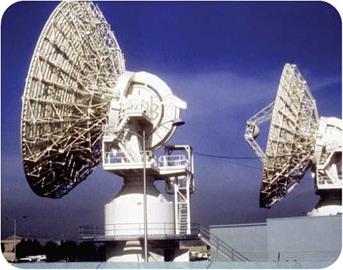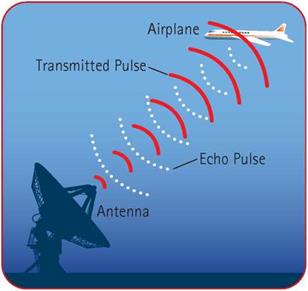How Radar Works
The basic principle of radar is very simple. It sends out radio waves and then picks up any waves that are reflected back. Most radar systems are more complex, however, and they can tell much more about an object than just the fact that it is there. They can show its location, bearing (direction), range (distance), velocity, and altitude.
A radar system has four main parts. A transmitter produces radar signals.
|
|
An antenna sends signals in the form of electromagnetic waves and picks up any reflections that return. A receiver amplifies the weak radar reflections and analyzes them. A display shows the received information on a screen.
Radar uses short radio waves called microwaves. The simplest type of radar is pulse radar. It sends out short bursts, or pulses, of radio waves and listens for any reflections that bounce back from a target, such as an aircraft. The direction from which the reflection comes shows the aircraft’s bearing. The time the pulse takes to bounce back gives its range.
Antennae
A dish-shaped antenna can be steered to scan a particular area of the sky. It may swing back and forth, or it may rotate so that it scans the whole sky in all directions. The most modern radar systems use a flat antenna that stays fixed in one place. A flat antenna is constructed from
О A simple radar has an antenna that sends out signals in the form of pulses of radio waves. It picks up any echo pulses that come back and uses them to measure an object’s distance and movement.
DOPPLER RADAR
When a police car races past sounding its siren, the sound rises in pitch as the car approaches and falls as it goes away. This is called the Doppler effect, and it happens with all kinds of waves, including microwaves. Radar equipment can be designed to make use of this effect. It can show if something is flying toward the radar antenna or away from it, and how fast. A type of radar called Doppler radar was developed in the 1960s. It uses continuous radar waves instead of pulses. Pulse – Doppler radar systems combine basic pulse radar systems with Doppler radar.
At first, Doppler radar was used mainly for weather forecasting. By the 1980s, Doppler weather radars were able to measure the speed and direction of raindrops inside clouds and storms. Portable Doppler radars carried on the back of trucks are used to study the most extreme weather systems, especially thunderstorms and tornadoes.
 thousands of small, electronic transmit – and-receive modules, and the radar beam is steered electronically. These radars are called electronically scanned arrays, or phased arrays. They can scan far faster than a rotating dish antenna, they can track many more targets, and – with fewer moving parts-they are more reliable.
thousands of small, electronic transmit – and-receive modules, and the radar beam is steered electronically. These radars are called electronically scanned arrays, or phased arrays. They can scan far faster than a rotating dish antenna, they can track many more targets, and – with fewer moving parts-they are more reliable.
Advanced combat aircraft, such as the F-22, are equipped with electronically scanned array radar. They can locate and track multiple high-speed targets and pass on the target information to the aircraft’s weapons systems.











